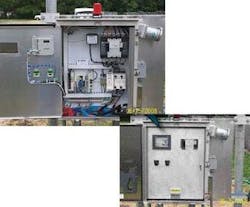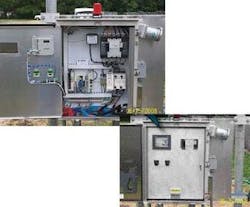by Grant Van Hemert
High horsepower municipal pumping has changed over the past decades with the advent of variable frequency drives (VFDs), soft starts and active harmonic filtering. But the majority of pump stations are low horsepower constant-speed, a design that has not significantly advanced since the Modicon Company's Modbus® serial protocol allowed direct monitoring via radio or telephone.
In the 1970s, when municipalities saw the benefits of transmitting remote pump information to a central location, Modbus protocol and other serial networks became the standard communication protocol.
Many municipalities still use serial networks. A typical pump station will transmit run and fail status of each pump, level status, and perhaps some other data such as door closure, or power on. While slow, typically 9600 to 19200 bits per second (baud), these networks do provide perfectly acceptable service.
Even though data transmission technology continued to evolve, the requirements for monitored data remained the same, so municipalities didn't see the need to change or upgrade transmission technologies.
Industrial Ethernet protocols, such as Modbus TCP, increased data rates on the magnitude of 10,000 times over serial, allowing for an incredible amount of data to be efficiently transmitted. Upgrading from serial to Ethernet requires new radios for each pump station and at the main base station. For many cash-strapped municipalities, even the increase in transmission speed and data did not provide a compelling reason to make the investment.
However, all that changed on September 11, 2001.
Homeland Security Impacts Data Needs
After 9/11, the Homeland Security Department (HSD) and the Environmental Protection Agency (EPA) established new guidelines for protecting the nation's water. Municipalities were encouraged to perform vulnerability assessments focusing on detecting, deterring, containing, and preventing acts of terrorism, ranging from catastrophic events to vandalism. In response, The EPA created 14 features of an effective water security program , including a detection and monitoring initiative related to contamination detection.
Among the EPA's guidelines are suggestions to place monitoring systems at key points in a distribution network. These monitors will detect parameters such as nitrates, nitrites, ammonia, pH, etc., and may also need to detect radiation and biological contaminants such as anthrax, ricin, and others.
An important facet of a contamination monitoring system design is physical security around the monitored area, including cameras located at the remote station. The EPA suggests two possible scenarios.
The first scenario is to install video recording devices at each site. This method is attractive since recorder costs and recording style cameras are relatively inexpensive. However, there are drawbacks. This is a delayed system in that a recording is typically viewed after an incident, so real-time monitoring is not possible. If the site is violated, the recording equipment is also vulnerable to theft or vandalism. Furthermore, depending on the system layout, personnel may have to cross a contaminated area to access the recording. Finally, if this is a large water distribution system with many contamination monitoring sites, the amount of recording equipment could introduce a logistical challenge from a maintenance and upgrade point of view.
The second scenario is to transmit the video signal back to the manned water or wastewater facility. This eliminates the local recording equipment and its vulnerability and maintenance concerns. Also, a transmitted video can offer real-time surveillance increasing the possibility of catching violators in the act, or providing a quick visual check on the system. The challenge with this system is communication speed.
Need for speed
Many utilities still use serial communication links that send data at 9600 to 19200 baud. For example, a utility might have 125 different pump stations on the network that examine the run and fail of three motors, four float levels, a door open alarm, and an AC power off alarm. Each of these serve as an on/off type signal and thus each equals a bit. For illustration purposes, let's say each packet is 100 bits. This means that at 9600 baud we can communicate to all 125 stations in about two seconds. Even with some network latency this process should take no more then 10 seconds for all 125 stations. This would still be an acceptable performance level.
However, if three contamination monitoring systems, each with water quality parameters and video are added to this example, a lot more data is generated.
To demonstrate, consider just one camera of the contamination monitoring system. According to Victor Duvanenko, an engineer at Pelco®, "images start out as a two-dimensional array of RGB (red, green, blue) elements (pixels) with 8-bits per color for a total of 24-bits per pixel. For example, if you have an instantaneous image that is 720 pixels wide and 480 pixels high, then a native, or uncompressed, image will take 720x480x24 bits of storage, for a total of 8,294,400 bits. At 9600 baud, this would take 864 seconds or 14.4 minutes to transmit the raw image."
"Because of compression," Duvanenko said, "our current video systems at 720x480 resolution produce instantaneous images that contain 66,400 bits. For clarity purposes, the transmission works best at 10 images per second. This results in 664,000 bits per each second of video. At 9600 baud, it would take about 69.2 seconds to transmit a single second of video."
Enter Ethernet
Ethernet is commonly found at 10Mbaud, and 100Mbaud, with 1Gbaud growing in popularity. To put this in perspective, a 10Mbaud signal is 1,042 times faster then a 9600 baud system, and a 1Gbaud is 104,200 times faster. So, a one-second compressed video would take a total of 0.066 seconds at 10Mbaud, or 0.00066 seconds at 1Gbaud. This rate is much more acceptable.
Utilities may adopt a hybrid communication method, in which an Ethernet network handles the contamination monitoring system and the existing serial network handles the existing pump stations. Compared to a total changeover, this saves money and further minimizes network loading. Once implemented, the advantages of Ethernet will probably result in an eventual total migration, abandoning the serial network over time.
Contamination Monitoring
Several locations can be used for contamination monitoring. Fire hydrants and point-of-use are not feasible locations due to issues related to architecture, private property, and response time. It is also not ideal to monitor tower discharge since the tower may already be completely compromised before detection occurs.
Dedicated locations may be needed in some instances, but the most feasible location for monitors is pump stations. These locations have access to the water, can prevent distribution of contaminated water (via pump stopping) and already have property and architectural restrictions addressed.
This placement presents an opportunity to combine the contamination monitoring system and pump controls. In this scenario, a single programmable controller can collect the water quality data and control the pumps.
Ethernet future
So what does the future pump station look like? It will be Ethernet based using VFDs or constant speed starters. These starters and drives will have Ethernet capability and provide control analysis tools. The station will have a programmable controller that will be able to communicate over Ethernet. In some instances, the programmable controller used for pump control also will be used to process water quality parameters of the contamination monitoring system.
When creating a pump station, care should be taken to select hardware which can handle today's serial needs plus tomorrow's Ethernet needs without requiring an upgrade in hardware.
Serial network communication, such as pioneered by the Modicon company, has given utilities decades of reliable service. However, a changing dynamic driven by the DHS and the EPA will require faster communication scenarios. These networks will be needed to support the added communications of water quality data and cameras. The adoption of these faster networks will also allow the adoption of devices with more diagnostic capabilities and enhanced maintenance features that cannot be achieved with a slower serial strategy.
Most importantly, these technologies will aid in ensuring that our water supply remains safe and secure.
Author's Note: For more information, see the following links: Water Infrastructure Security Enhancements Project, (http://www.wef.org/ScienceTechnologyResources/WaterSecurity/WaterInfrastructureSecurityEnhancements.htm), and groundwater monitoring (http://acwi.gov/sogw/index.html)
About the Author:
Grant Van Hemert, P.E., is an application engineer for the Schneider Electric Water Wastewater Competency Center. Located in Raleigh North Carolina, he is responsible for identifying market drivers and development of automation and control solutions for the water and wastewater markets. Van Hemert received his Bachelor of Science degree in electrical engineering technology from Indiana State University. He is a registered professional engineer in the state of North Carolina.




